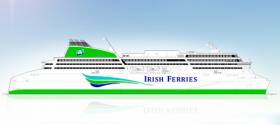Displaying items by tag: FSG Germany
White-Hot As Plasma Splits Steel for Brittany Ferries English Channel Newbuild Honfleur
#FerryNews - It was getting white-hot as plasma jets cut through sheets of steel for Brittany Ferries English Channel newbuild cruiseferry Honfleur at the FSG shipyard Germany, which is completing Irish Ferries W.B. Yeats due to enter service this summer.
The steel cutting ceremony of Brittany Ferries’ Honfleur on Monday, marked the first step of the cruiseferry that will take little over a year to complete. By June 2019, the metal being cut will form part of a complex and complete 42,400 gross-tonne vessel, powered by liquefied natural gas (LNG), making her first crossing from Portsmouth to Caen, Normandy.
“This is a very exciting day for everyone at Brittany Ferries,” commented Christophe Mathieu, Brittany Ferries CEO speaking from the yard. “In little over one year, a mighty ship will rise, ready to carry passengers in comfort, style and on the cleanest vessel regularly operating on the Channel. Today’s ceremony is like a glimpse into the future of sustainable ferry travel. It is a future that is not so far away for millions of holidaymakers and freight customers.”
Brittany Ferries will tell the story of the build through a new website, www.destinationhonfleur.com . It will host regular news updates, video interviews and a stunning gallery featuring shipbuilding and destination imagery, all free to download in high res.
Steel cutting, of course, is not the start of the process. Before Honfleur is built in steel, she is built virtually. Every other cut and weld has been carefully planned, along with the countless other operations required to build such a complex craft. For shipbuilding in the 21st century is as much about CAD design, complexity management and logistics as it is about forming steel.
When complete, Honfleur will carry up to 1,680 passengers, 550 cars and 64 trailers and come with 261 cabins, two cinemas, restaurants, boutique shopping and expansive passenger lounges. Wi-Fi will come as standard in all areas of the ship, including cabins and access from the car decks to passenger areas will be made as easy as possible for all passengers.
She will be the first ferry regularly operating on the English Channel, powered by LNG (liquefied natural gas). This fuel emits less carbon dioxide during combustion than diesel and burns with no smoke. It is entirely free of sulphur and produces very low emissions of nitrogen oxide and particulate matter. Her dual fuel engines coupled with LNG-electric propulsion will bring further efficiency, as well as a smoother and quieter ride for passengers.
Overseeing the project is naval architect Brice Robinson, working on his fifth vessel for the company. He is based in Germany with a team for the duration of the build. “Building a ship is a little like cooking,” he summarised. “It’s a recipe that requires the same quality ingredients, but you optimise the mix every time during its preparation. And with experience, you make it better and better.”
Project: Honfluer milestones:
Steel cutting: March 2018
Keel laying: August 2018
Launch: December 2018
Sea trials: March 2019
Delivery /naming ceremony: May 2019
Entry into service: June 2019
Bringing Building Blocks to Make W.B. Yeats All Ship-Shape
#FerryNews - Progress on Irish Continental Group's €150m cruiseferry W.B. Yeats has considerably moved on since the launch of the completed hull at a German yard almost a month ago, writes Jehan Ashmore.
Construction of the newbuild's hull (photos) was kept separate to where the accommodation superstructure was built. This took place place in various facilities in neighbouring Poland. The superstructure housing facilities for 1,885 passengers and cabins totaling 435 was constructed using three giant blocks.
According to Poland @ Sea, each of the block sections;fore, amidships and aft were towed on barge-pontoons (see photos) from Poland to Flensburger Schiffbau-Gesellschaft (FSG) in Flensburg. The technical and logistical exercise involved precise engineering skills when massive heavy-lift crane barges raised and lowered the component blocks onto the hull below.
Afloat has also been monitoring the time-schedule of this operation, as the final aft block section complete with funnel was placed into position last week at the fit-out berth at FSG.
In all the combined weight of the newly formed superstructure totals 5,500 tonnes. As for the length of the hull at 195m, this is longer to the capital's iconic ‘Spire’ if laid on its side which measures at just 120m.
As previously reported, in the course of the next few months, remaining construction work on the hull (where most of the 3kms of vehicle deck space is) will be completed. In addition the fitting-out of the 54,985 gross tonnage ferry entails technical, operational, décor, furnishings and passenger amenities to be finished. This will make the ferry the most luxurious on the Irish Sea where some cabins will feature balconies which will be put to greater use on the longer French service.
Before scheduled services can commence, W.B. Yeats will undergo sea trials, crew training and docking procedures at French, UK and Irish ports into which it will operate. The maiden commercial voyage is scheduled to take place on the direct continental Dublin-Cherbourg route in mid-July and where the cruiseferry will serve the busy summer months.
In the Autumn, W.B. Yeats will transfer to the core Irish Sea route of Dublin-Holyhead. This leaves services maintained on the year-round Ireland-France route to be operated by ropax Epsilon.
In the meantime, Irish Ferries Rosslare-Cherbourg route for this season resumes service today with a night-time departure. As usual routine cruiseferry Oscar Wilde will serve the continental route. The cruiseferry fresh from annual refit has been on temporary relief duties on the Holyhead route in addition to carrying out a once-off Dublin-Cherbourg round trip last weekend.
The re-deployment of Oscar Wilde was to facilitate Epsilon while also undergoing overhaul though the ferry is take up duties again on both the Dublin routes to Wales and France. The latter service sees the ropax return on the Dublin-Cherbourg service tomorrow mid-afternoon.
























































